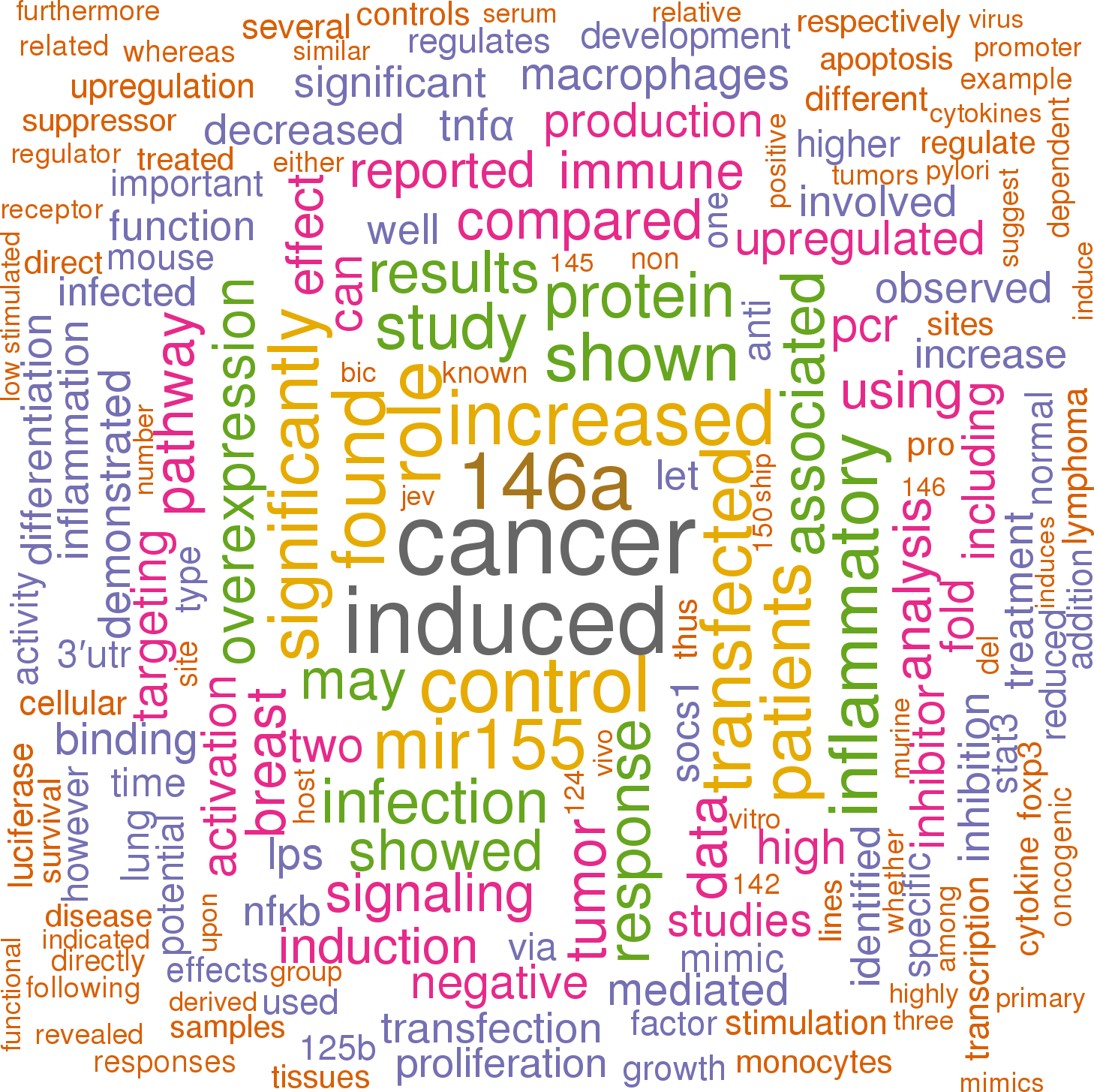Accession
MI0000681
Symbol
HGNC:
MIR155
Description
Homo sapiens
hsa-mir-155 precursor miRNA mir-155
Gene
family?
family?
RF00731;
mir-155
Summary
Caution, this is an AI generated summary based on literature. This may have errors. ?
MIR155 is a noncoding microRNA transcript of the B-cell integration cluster gene, implicated in the regulation of various cellular processes, including immune response and oncogenesis [PMC7912829]. It has been observed to play a role in osteogenic differentiation, with its inhibition leading to upregulated osteogenesis of mesenchymal stem cells [PMC9288680]. Studies using MIR155 knockout mice suggest its involvement in macrophage accumulation and metabolic profile regulation in obesity settings [PMC5617927]. MIR155 is also associated with autophagic activity, with its overexpression increasing and knockdown alleviating autophagy under hypoxic conditions [PMC4389881]. Its role extends to vascular smooth muscle cell proliferation and has been proposed as a potential target for future research on vascular calcification using cell type-specific knockout models [PMC7123062], [PMC7810936]. Additionally, MIR155 is recognized as an oncomiR due to its involvement in various cancers including breast cancer, leukemia, lymphoma, lung cancer, and liver cancer [PMC5361868]. Its expression profile has been associated with the diagnosis and progression of breast cancer when examined alongside other microRNAs [PMC3046429]. Furthermore, MIR155's regulatory effects on immune cells have been highlighted for their potential implications in autoimmune diseases such as rheumatoid arthritis [PMC8534545], [PMC5351619].
Literature search

1009 open access papers mention hsa-mir-155
(8276 sentences)
(8276 sentences)
Sequence
84128
reads,
459
reads per million, 127 experiments
cugUUAAUGCUAAUCGUGAUAGGGGUUuuugccuccaacugaCUCCUACAUAUUAGCAUUAACAg
((((((((((((((.(((.((((((((.(((....)))..)))))))))))))))))))))))))
((((((((((((((.(((.((((((((.(((....)))..)))))))))))))))))))))))))
Structure
C A -u c
cugUUAAUGCUAAU GUG UAGGGGUU uug c
|||||||||||||| ||| |||||||| |||
gACAAUUACGAUUA UAC AUCCUCag aac u
- - uc c
Annotation confidence
High
Do you think this miRNA is real?
Comments
Human mir-155 is predicted based on homology to a cloned miR from mouse (MIR:MI0000177) [1], and later experimentally validated in human HL-60 leukemia cells [2]. Like the mouse miRNA, human mir-155 resides in the non-coding BIC transcript (EMBL:AF402776), located on chromosome 21 [3]. The mature form differs from that in mouse at a single position. Eis et al. confirm that miR-155 is processed from the BIC transcript in human, and demonstrate elevated expression of miR-155 in lymphoma samples [4]. The mature sequence shown here represents the most commonly cloned form from large-scale cloning studies [5].
Genome context
chr21: 25573980-25574044 [+]
Disease association
hsa-mir-155 is associated with one or more human diseases in the Human microRNA Disease Database
| Disease | Description | Category | PubMed ID |
|---|
Biological pathways
hsa-mir-155 is involved in one or more biological pathways:
(Source: Reactome)
(Source: Reactome)
Biological reactions
hsa-mir-155 is involved in one or more regulation/signalling events:
(Source: Reactome)
(Source: Reactome)
Mature hsa-miR-155-5p
| Accession | MIMAT0000646 |
| Description | Homo sapiens hsa-miR-155-5p mature miRNA |
| Sequence | 4 - UUAAUGCUAAUCGUGAUAGGGGUU - 27 |
| Evidence |
experimental
cloned [2,5-7] |
| Database links |



|
| Predicted targets |



|
Mature hsa-miR-155-3p
| Accession | MIMAT0004658 |
| Description | Homo sapiens hsa-miR-155-3p mature miRNA |
| Sequence | 43 - CUCCUACAUAUUAGCAUUAACA - 64 |
| Evidence |
experimental
cloned [5] |
| Database links |



|
| Predicted targets |



|
References
|




